A lot of players who play the Queen’s Gambit with the White pieces rush to push their pawn with c5, especially those who aren’t experienced enough in the line. In this article, we will discuss why it’s a bad choice, in chess and in psychological terms.
Table of Contents
Drawbacks of White Playing c5 In QGC
The following reasons explain why it’s bad to push c5 from a chess perspective –
White Releases The Tension In The Centre
One of the main ideas of the Queen’s Gambit is to build the tension on the Black’s d5-pawn. After pushing c4-c5, this tension is released.
As a result, Black’s e6-pawn no longer needs to defend the d5-pawn actively.
Now, Black can start to think of taking a central break with …e6-e5. Often after White pushes their pawn to c5, Black rallies to take this central break by the means of playing …Nbd7, …Re8, …Bf8 and …e5.
It Becomes Difficult To Get The Central Break e4
After closing the centre with c5, if White pushes e4, Black can take the pawn with …dxe4. As a result of …dxe4 –
- White is left with a backward pawn on d4 and Black has an open d-file to mount up the pressure on that pawn.
- The d5-square will be an outpost for one of Black’s pieces, as White cannot kick it with c4 or e4 move.
Because of these reasons, playing e4 becomes difficult. This means White’s pawn will be on e3 and Black can push their pawn with …e5. Sometimes, they can even go …e5-e4, gain space in the centre and follow it up with a kingside attack …f5, …f4 etc.
On the other hand, White could try the push f3-e4. It will take time, but when White plays f3, they weaken the g1-a7 diagonal. At the perfect moment, Black can switch the play to the queenside and undermine White’s c5 pawn with …b6!, exploiting the weakened diagonal.
White’s Play Becomes Predictable
We saw above it’s difficult for White to take the central break with e4. The other reasonable option for White is to create play on the queenside with b4,a4, b5 etc. Also White gains space on the queenside with the move c5. This means their play will more or less be focussed on that side of the board.
Once Black knows this, they can play accordingly. For instance, they could launch a central break with …e5 and undermine White’s centre or they could even challenge White on the queenside with …b6-a5 etc. Black has many decent options to choose from.
Now let’s see some of the psychology behind this dubious push.
The Psychological Factors Behind c5 Push in Queens Gambit
These factors could be something a chess player is consciously aware or unaware of. Here, we want to shed light on them –
The Player Can’t Maintain The Tension
One of the hallmarks of a strong chess player is that they always strive to maintain the tension, even when it’s difficult. In order to maintain the tension, you must be able to calculate different variations in your head.
When it becomes difficult to do these calculations, a player releases the tension so that it becomes easier to gain clarity in the position.
The drawback is that in doing so, they also make their opponent’s life easier. Since the tension is gone, there’s one less dangling sword on your opponent’s head.
For example – With the pawn on c4 in the QGD, you always have to calculate what to do after …dxc4. After you push c5, you close this option and don’t need to calculate it. So does your opponent, which makes it easier for them.
Impulsive Decision
Often a lot of players push c5, thinking that they are gaining space on the queenside and after b4, a4, Rb1 b5, they will have a huge initiative there. Do you also think like that?
If so, you might be thinking about what’s best for you, while underestimating your opponent’s reply. As a result, you might not pay enough attention to their plans.
Also since your play becomes predictable after c5, your opponent is in a much better place to anticipate your plans.
Does This Mean Pushing c5 Is Always Bad In The Queen’s Gambit?
No. Exceptions do exist. If you’re gaining a lightning quick attack on the queenside or if you can smother Black for space, the c5-push can be effective.
But in most cases, Black is better prepared to take advantage of this push with their own pawn break, …e5 or …b6.
That’s why you will rarely see top level games where White goes for this push.


